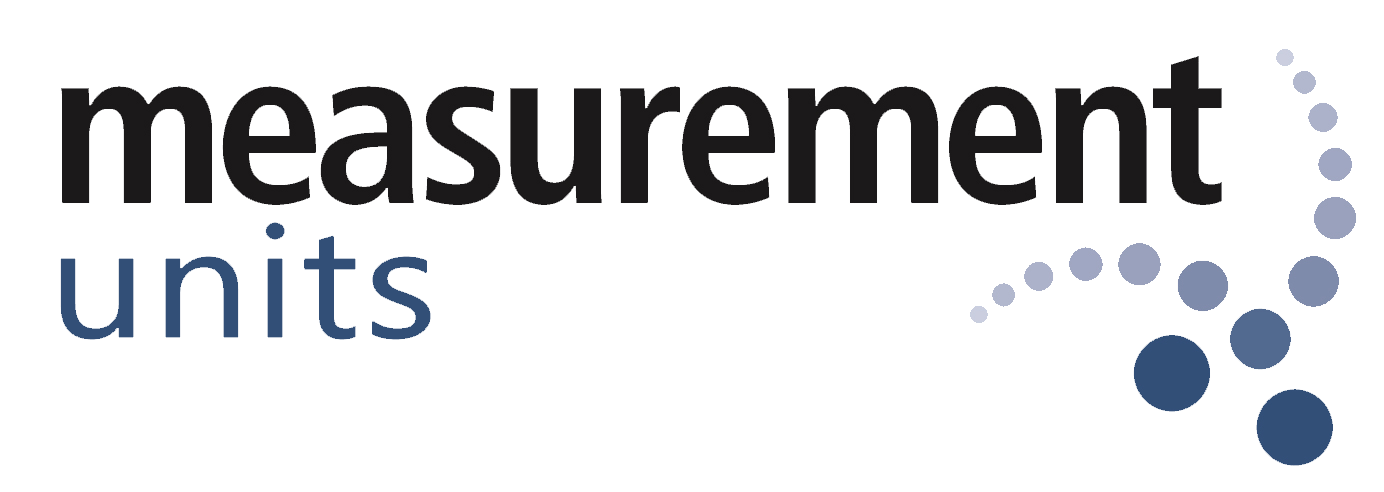In the world of men’s fashion, the difference between a good suit and a great one often boils down to the fit. Whether you’re dressing up for a special occasion, a business meeting, or simply aiming to elevate your everyday style, understanding how to measure for a suit is a crucial skill. This guide will take you through the step-by-step process of obtaining accurate measurements for a suit tailored to the UK fashion scene.
Before diving into the measurements, it’s essential to gather the necessary tools and equipment. All you need is a measuring tape and, ideally, a friend or a full-length mirror to ensure precision. Additionally, wear the type of clothing you would typically pair with a suit, as this ensures accurate measurements.
Measure a suit in a few simple steps
Measuring the suit jacket is a crucial step in ensuring a perfectly tailored fit. To start, measure your chest at its widest point, just under your armpits, making sure the tape is snug but not too tight. Next, measure your waist, around the narrowest part of your torso. For the jacket length, begin at the base of your neck, then run the tape down to where you want the jacket to end. It’s essential to strike a balance between a traditional or contemporary look based on your preferences.
Chest Measurement
Step-by-Step Guide for Chest Measurement:
- Start by wrapping the measuring tape around the fullest part of your chest, ensuring it’s snug but not tight.
- Keep the tape parallel to the ground, ensuring it runs across the shoulder blades.
- Take the measurement while standing upright with your arms relaxed at your sides.
- Repeat the process for accuracy, and record the larger of the two measurements.
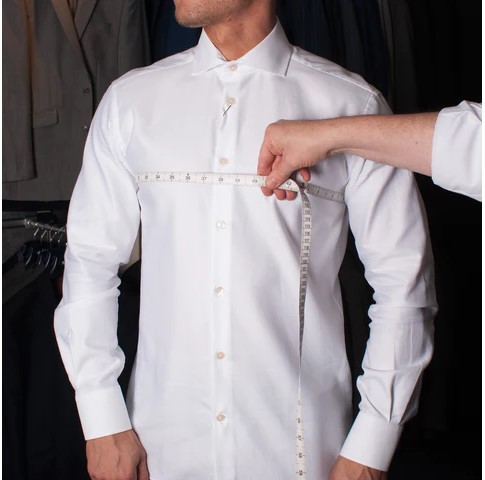
Image source: leonardsilver
Proper Technique for Waist Measurement:
- Locate your natural waistline, typically an inch above your belly button.
- Wrap the measuring tape around your waist, ensuring it’s snug but not constricting.
- Keep the tape parallel to the ground for an accurate measurement.
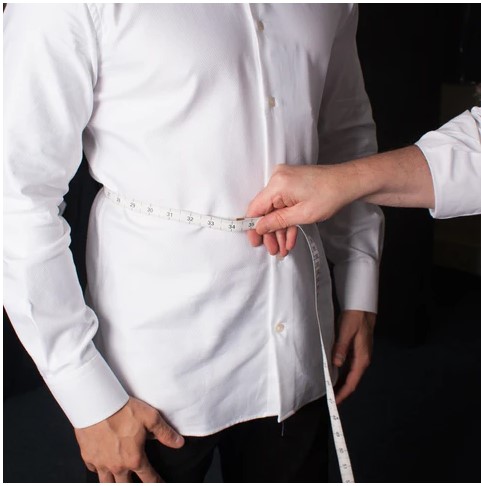
Image source: leonardsilver
Tips for Accuracy:
- Stand up straight and avoid slouching to get an accurate reading.
- Relax your stomach muscles for a true representation of your waist size.
Hip Measurement (if applicable)
- Guidance on Measuring Hips:
- Measure around the fullest part of your hips and buttocks.
- Ensure the tape is parallel to the ground and not too tight.
- Record the measurement for reference.
- Considerations for Different Suit Styles:
- Depending on the suit style (e.g., slim fit, regular fit), the hip measurement may impact the overall comfort and appearance.
Jacket Measurements
Measuring the jacket accurately is key to achieving a well-fitted and stylish look. Start by determining the jacket length, which sets the overall silhouette. Measure from the base of your neck, down the spine, to the desired endpoint. Whether opting for a classic or modern fit, this measurement plays a pivotal role in the jacket’s proportionality. Shoulder width is crucial for a comfortable and flattering fit.
Length of the Jacket
- Determining the Correct Jacket Length:
- Measure from the base of the neck to the point where you want the jacket to end.
- The standard length typically reaches the knuckles when your arms are at your sides.
- Adjust the measurement based on personal preference, considering trends and your body proportions.
- Adjustments Based on Personal Preference:
- Shorter jackets can create a modern and trendy look, while longer jackets exude a more traditional and classic style.

Image source: kiwisizing
Shoulder Width
- Measuring Shoulder Width Accurately:
- Measure across the back, from the outer edge of one shoulder to the outer edge of the other.
- Ensure the tape is parallel to the ground and not slanting.
- Significance of Proper Shoulder Fit:
- A well-fitted shoulder is crucial for comfort and overall appearance.
- Avoid jackets with shoulders that are too tight or too loose, as they can compromise the entire look.

Image source: kiwisizing
Trouser Measurements
Inseam Length
- Measuring the Inseam Correctly:
- Measure from the crotch to the bottom of the ankle or desired trouser length.
- Keep the tape straight and taut for an accurate measurement.
- Customization Options for Different Trouser Styles:
- Consider the desired break, whether it’s a full break, half break, or no break at all, and adjust the inseam accordingly.
- Different trouser styles may require varying lengths, so tailor the inseam to complement the overall look.
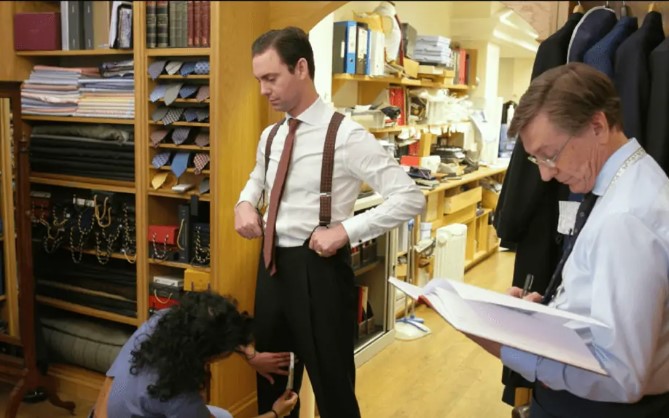
Image source: kiwisizing
Waistband and Hip Measurements
- Ensuring a Comfortable Fit Around the Waist and Hips:
- Measure around the waist at the level where the trousers will sit comfortably.
- Ensure the tape is snug but not tight.
- Measure around the fullest part of the hips to ensure a comfortable fit.
- Tailoring Considerations for Trousers:
- Trousers can be tailored for a more tapered or relaxed fit, depending on personal preference.
- Discuss any specific tailoring requests with a professional if needed.
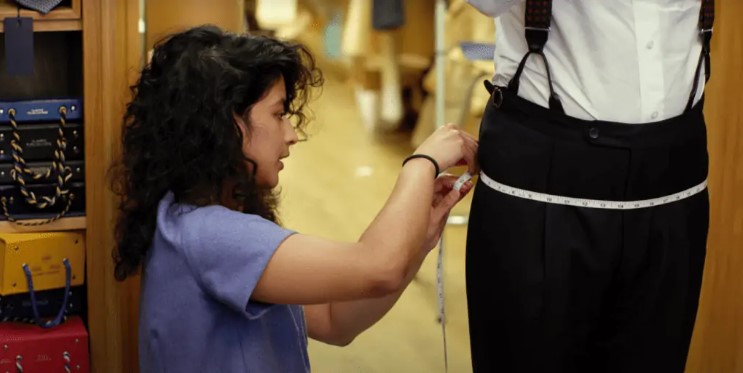
Image source: kiwisizing
Additional Tips
Considerations for Different Suit Styles (e.g., Slim Fit, Regular Fit)
- Different suit styles cater to various body types and fashion preferences.
- Slim fit suits provide a modern and streamlined appearance, while regular fit suits offer a classic and comfortable silhouette.
- Tailor your measurements to align with the chosen suit style for optimal results.
Sizing Variations Among Different Brands
- Sizing can vary between brands, so it’s essential to refer to each brand’s sizing chart.
- If shopping online, read customer reviews for insights into the fit and sizing of specific brands.
Seeking Professional Assistance if Unsure
- If uncertain about taking measurements or choosing the right size, consider seeking assistance from a professional tailor.
- Many department stores and boutique shops offer in-store tailoring services to ensure a perfect fit.
Conclusion:
In conclusion, mastering the art of measuring for a suit is a fundamental skill for any fashion-conscious individual, especially in the UK where a well-tailored suit is a style staple. By following the step-by-step guide provided in this comprehensive outline.
You’ll be equipped to obtain precise measurements that guarantee a suit tailored to perfection. Remember, a well-fitted suit not only enhances your appearance but also boosts confidence, making a lasting impression in any setting.
Frequently Asked Questions (FAQs)
To measure yourself for a suit, use a tailor’s tape measure. For the chest, wrap the tape under your armpits. Measure your waist at its narrowest point, and for the jacket length, start from the base of your neck down to your desired endpoint. Shoulder width is measured across your back, ensuring a comfortable fit.
Suit size is typically calculated based on your chest measurement. Measure the fullest part of your chest and match it to the corresponding size on a size chart. Consider your height and weight as well. Jackets often come with a regular (R), long (L), or short (S) designation, indicating the length proportion.
In suit sizing, “42R” refers to a jacket size where 42 is the chest measurement and R stands for regular length. It indicates a standard jacket length for someone with a 42-inch chest, providing a balanced fit for average height individuals.
To measure suit size in the UK, follow the same chest measurement guidelines. Use a tailor’s tape to measure your chest at its widest point. Match this measurement with the UK sizing chart. Take note of any additional size indicators like short (S), regular (R), or long (L) to ensure a well-proportioned and comfortable fit.
